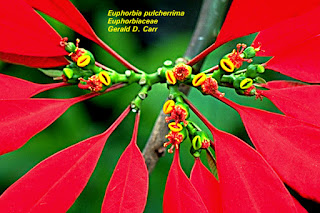Special Type of Inflorescence: Cyathium
Cyathium: Inflorescence Of The Euphorbiaceae Family-
One of the largest genera of flowering plants is Euphorbia with approximately 2,000 species. This enormous genus belongs to the very diverse euphorbia family (Euphorbiaceae) with at least 7,500 species. The variation within this genus is astonishing, from low-growing garden weeds called spurges to giant, cactus-like succulents that rival in size our North American sahuaro and organ-pipe cacti. South African euphorbias have evolved succulent, spine-covered stems that greatly resemble North American cacti, a biological phenomenon known as convergent evolution. It is difficult to believe that all these diverse forms belong to the same genus as the showy garden euphorbia called poinsettia (E. pulcherrima) until you carefully examine the blossom. The showy, red, modified leaves of poincettia are not petals. In fact, they are not even part of the true flowers. They surround clusters of small, greenish, cup-shaped structures called cyathia. Each cyathium is actually a flower cluster or inflorescence containing unisexual, apetalous male and female flowers. The inconspicuous male flowers occur in clusters and are reduced to a single red stamen, while the female flower consists of a single ovary (pistil) on a stalk (pedicel). In poinsettia the ovary is hidden within the cyathium, but in other species the ovary protrudes out of the cyathium at maturity. The rim of the cyathium also bears one-several, greenish nectar glands that are attractive to insect pollinators. In some species the glands are subtended by petal-like bracts (petaloid appendages). Poinsettias typically have only one greenish gland per cyathium and no petaloid appendages. This flower plan is quite different from the typical floral plan, but it is the basic theme in virtually all members of the amazing genus Euphorbia




Comments
Post a Comment